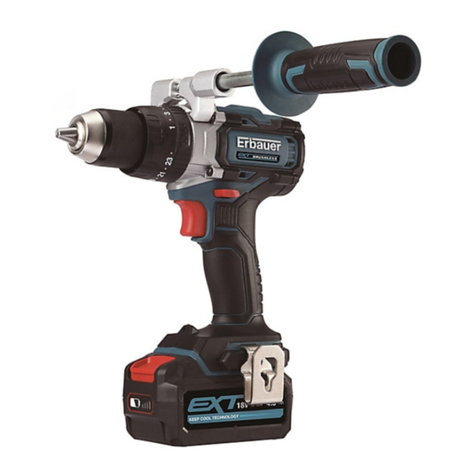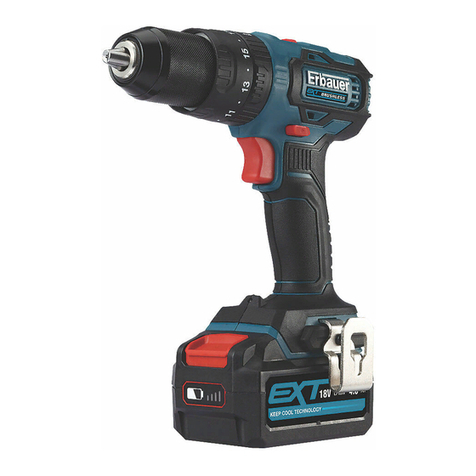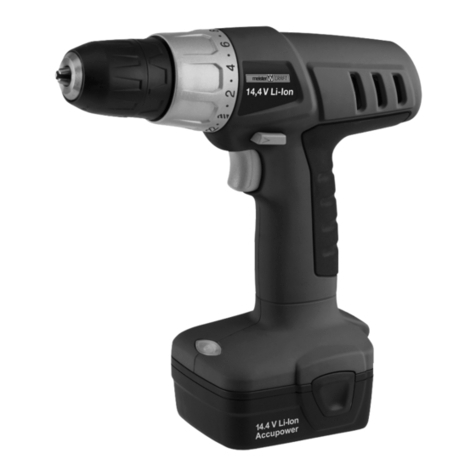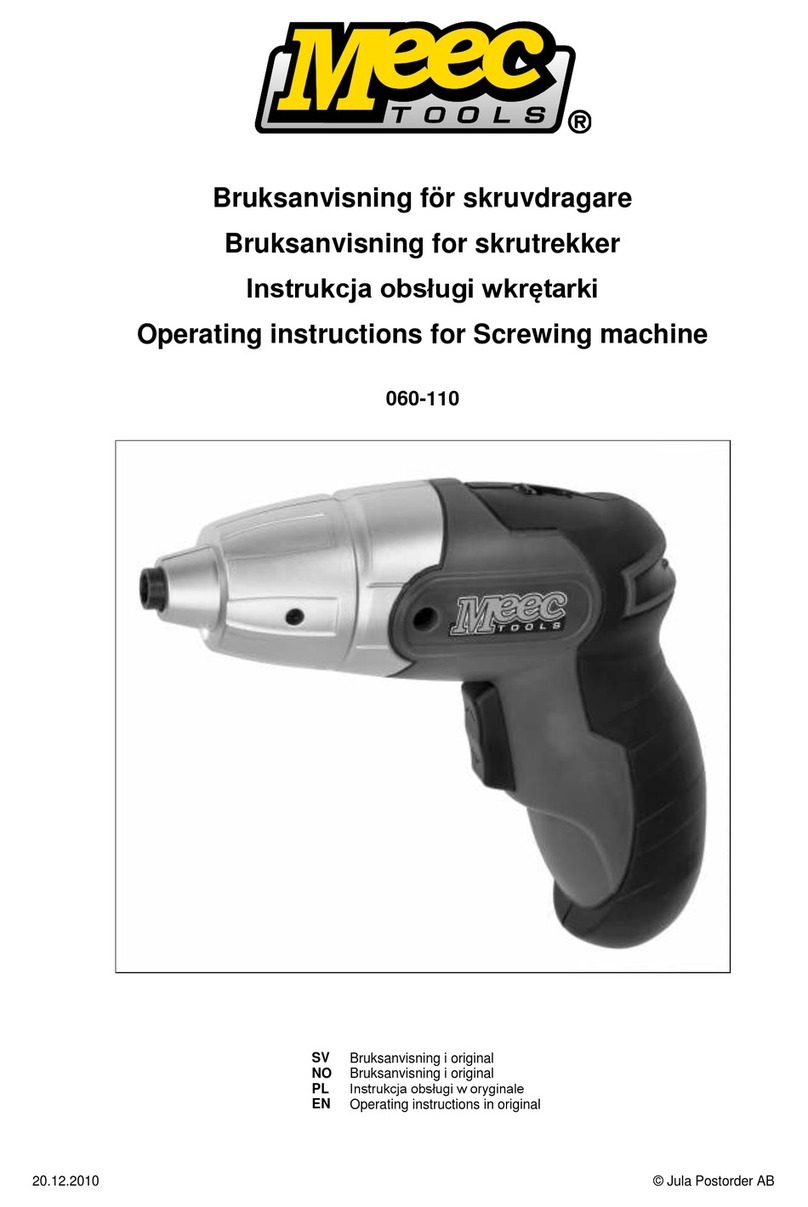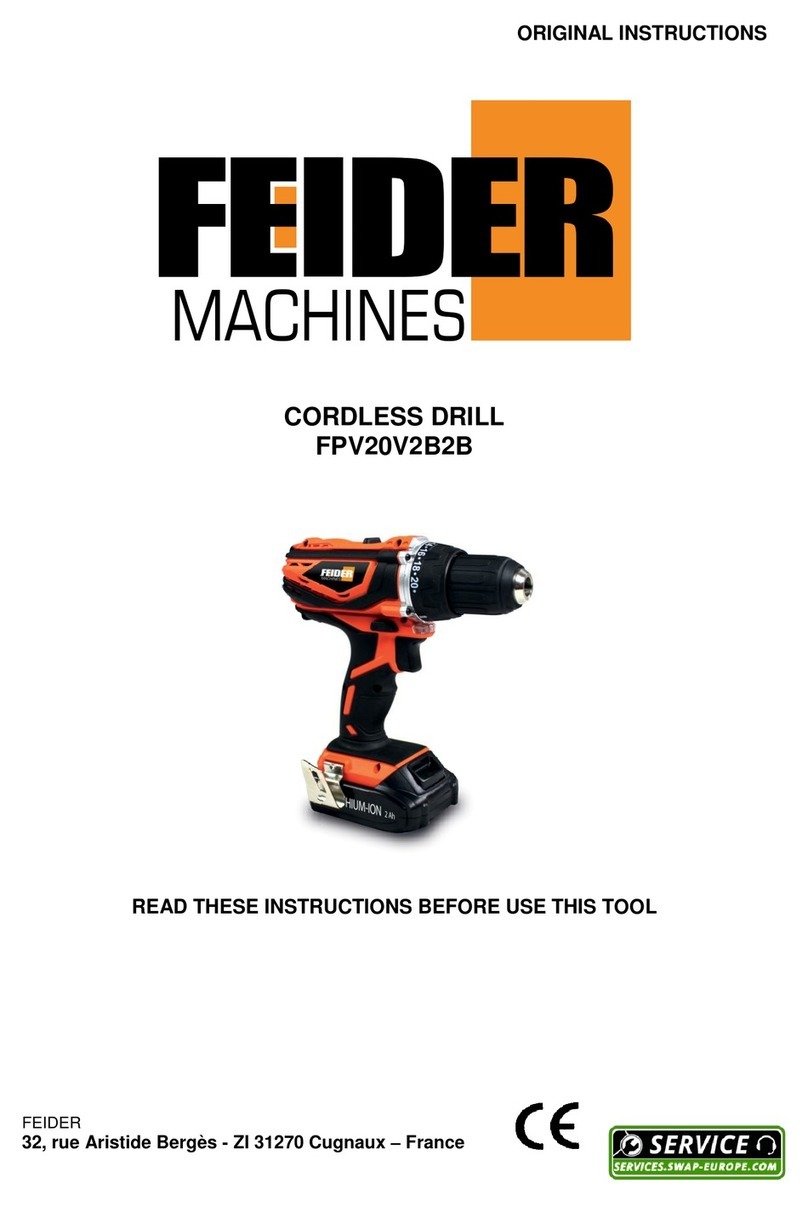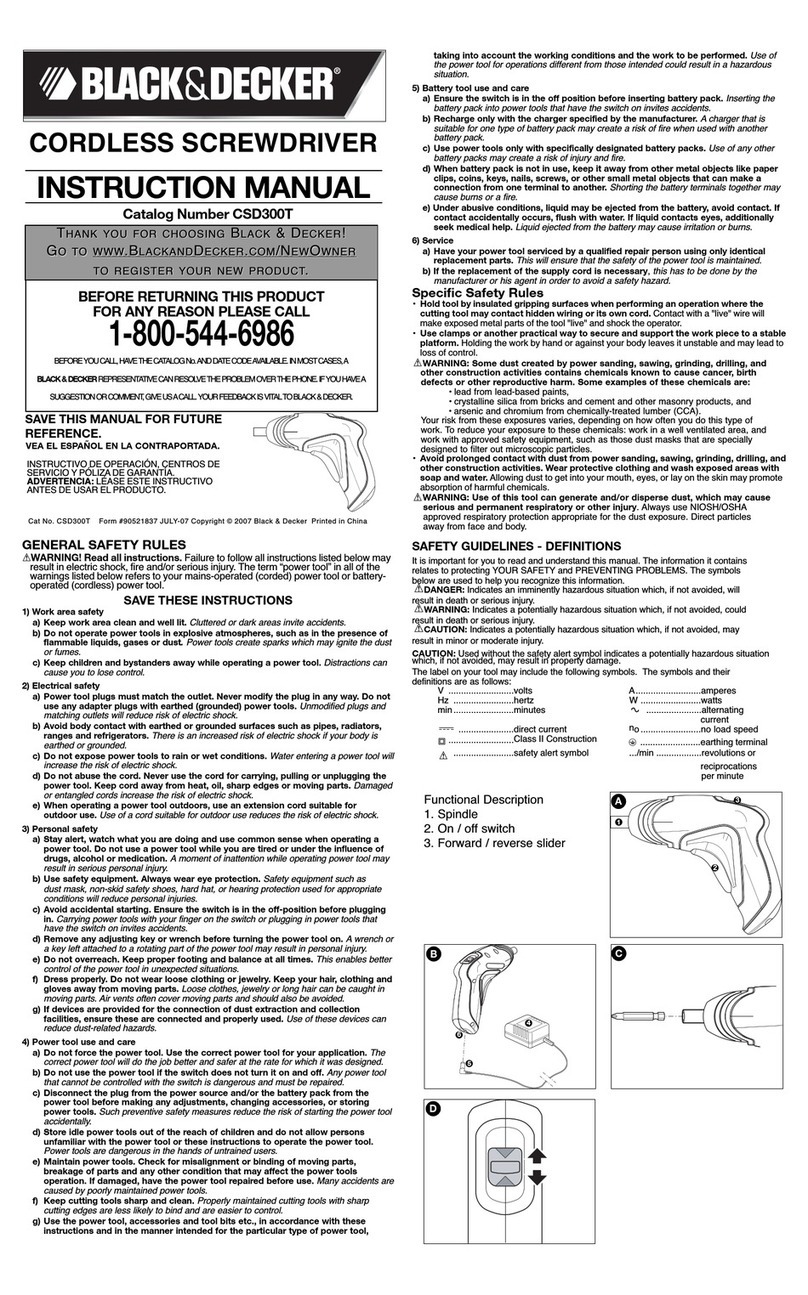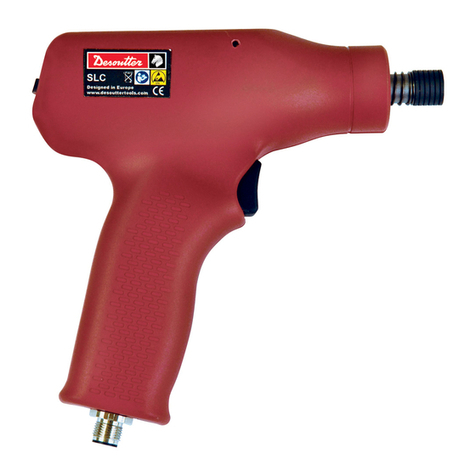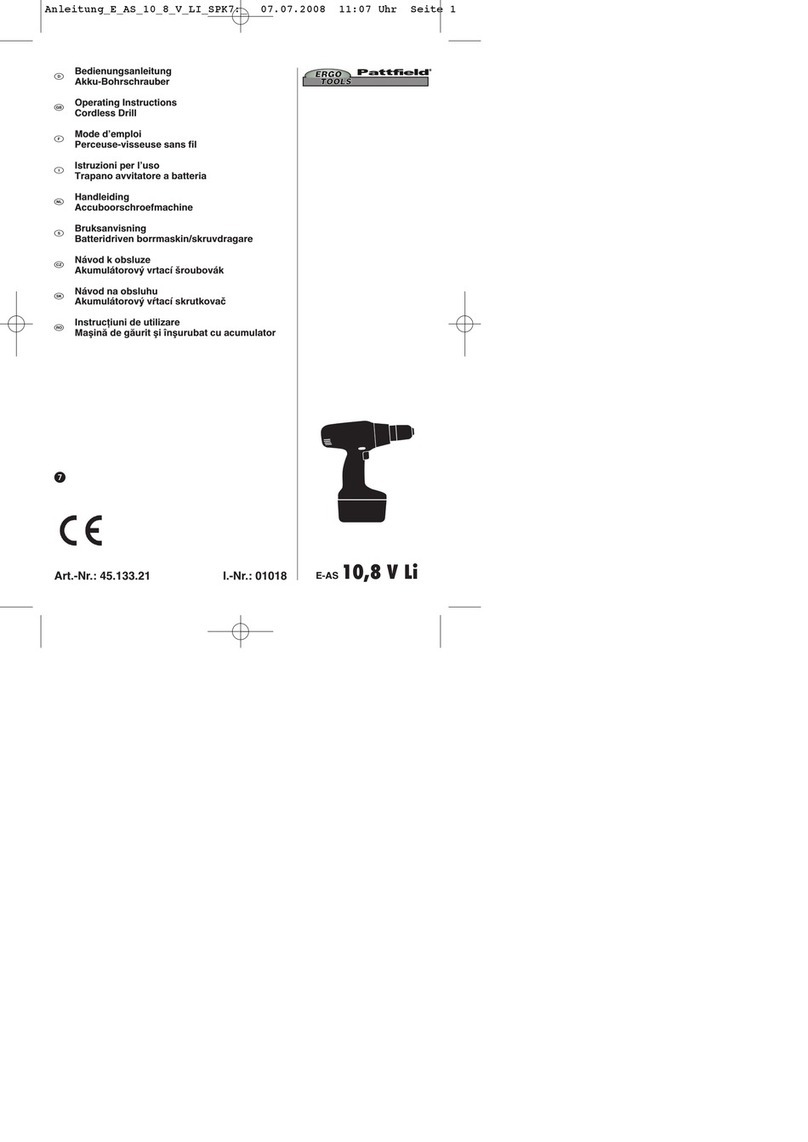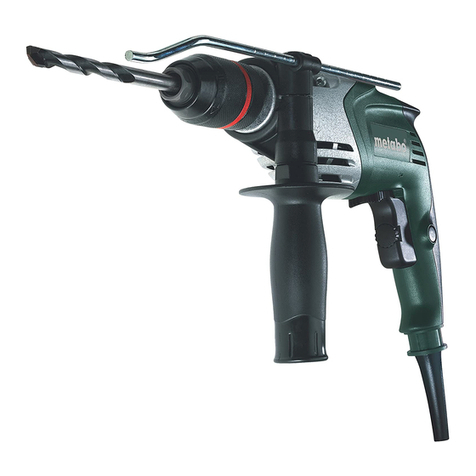Erbauer EDD12-Li-2 User manual

EDD12-Li-2
MNL_EDD12-Li-2_V01_180608
EAN. 3663602798712 \ EAN.3663602798996
ORIGINAL INSTRUCTIONS

3
2
Safety instructions
Product description
Assembly
Use
Care & maintenance
Guarantee
Declaration of Conformity
WARNING! Please read all safety warnings carefully and be sure
that they are fully understood before handling the tool.
x1
EAN. 3663602798712

5
4
PRODUCT DESCRIPTION
2 3
4
5
6
7
8
1a
1b
1
9
10
A1
2
1
A2
B C1
C2 C3
D E1
E2 F

7
6
G
SAFETY INSTRUCTIONS
GENERAL POWER TOOL SAFETY WARNINGS
WARNING! Read all safety warnings, instructions,
illustrations and specications provided with this
power tool. Failure to follow all instructions listed below
may result in electric shock, re and/or serious injury.
Save all warnings and instructions for future
reference. The term “power tool” in the warnings refers
to your mains-operated (corded) power tool or battery
operated (cordless) power tool.”
WORK AREA SAFETY
a. Keep work area clean and well lit. Cluttered or dark areas
invite accidents.
b. Do not operate power tools in explosive atmospheres,
such as in the presence of ammable liquids, gases or dust.
Power tools create sparks which may ignite the dust or fumes.
c. Keep children and bystanders away while operating a
power tool. Distractions can cause you to lose control.
ELECTRICAL SAFETY
a. Power tool plugs must match the outlet. Never modify the
plug in any way. Do not use any adapter plugs with earthed
(grounded) power tools. Unmodied plugs and matching
outlets will reduce risk of electric shock.
b. Avoid body contact with earthed or grounded surfaces,
such as pipes, radiators, ranges and refrigerators. There
is an increased risk of electric shock if your body is earthed or
grounded.

9
8
c. Do not expose power tools to rain or wet conditions. Water
entering a power tool will increase the risk of electric shock.
d. Do not abuse the cord. Never use the cord for carrying,
pulling or unplugging the power tool. Keep cord away
from heat, oil, sharp edges or moving parts.Damaged or
entangled cords increase the risk of electric shock.
e. When operating a power tool outdoors, use an
extension cord suitable for outdoor use. Use of a cord
suitable for outdoor use reduces the risk of electric shock.
f. If operating a power tool in a damp location is unavoidable,
use a residual current device (RCD) protected supply. Use
of an RCD reduces the risk of electric shock.
PERSONAL SAFETY
a. Stay alert, watch what you are doing and use common
sense when operating a power tool. Do not use a power tool
while you are tired or under the inuence of drugs, alcohol
or medication. A moment of inattention while operating power
tools may result in serious personal injury.
b. Use personal protective equipment. Always wear eye
protection. Protective equipment such as a dust mask, non-
skid safety shoes, hard hat, or hearing protection used for
appropriate conditions will reduce personal injuries.
c. Prevent unintentional starting. Ensure the switch is in the
off- position before connecting to power source and/or
battery pack, picking up or carrying the tool.Carrying power
tools with your nger on the switch or energising power tools
that have the switch on invites accidents.
d. Remove any adjusting key or wrench before turning the
power tool on. A wrench or a key left attached to a rotating
part of the power tool may result in personal injury.
e. Do not overreach. Keep proper footing and balance at
all times. This enables better control of the power tool in
unexpected situations.
f. Dress properly. Do not wear loose clothing or jewellery.
Keep your hair, clothing away from moving parts. Loose
clothes, jewellery or longhair can be caught in moving parts.
g. If
devices are provided for the connection of dust
extraction and collection facilities, ensure these are
connected and properly used. Use of dust collection can
reduce dust-related hazards.
h. Do not let familiarity gained from frequent use of tools
allow you to become complacent and ignore tool safety
principles. A careless action can cause severe injury within a
fraction of a second.
POWER TOOL USE AND CARE
a. Do not force the power tool. Use the correct power tool for
your application. The correct power tool will do the job better
and safer at the rate for which it was designed.
b. Do not use the power tool if the switch does not turn it
on and off. Any power tool that cannot be controlled with the
switch is dangerous and must be repaired.
c. Disconnect the plug from the power source and/or remove
the battery pack, if detachable, from the power tool before
making any adjustments, changing accessories, or storing
power tools. Such preventive safety measures reduce the risk
of starting the power tool accidentally.
d. Store idle power tools out of the reach of children and do
not allow persons unfamiliar with the power tool or these
instructions to operate the power tool. Power tools are
dangerous in the hands of untrained users.
e. Maintain power tools and accessories. Check for
misalignment or binding of moving parts, breakage of
parts and any other condition that may affect the power
tools operation. If damaged, have the power tool repaired
before use. Many accidents are caused by poorly maintained
power tools.

11
10
f. Keep cutting tools sharp and clean. Properly maintained
cutting tools with sharp cutting edges are less likely to bind and
are easier to control
g. Use the power tool, accessories and tool bits etc. in
accordance with these instructions, taking into account
the working conditions and the work to be performed. Use
of the power tool for operations different from those intended
could result in a hazardous situation.
h. Keep handles and grasping surfaces dry, clean and free
from oil and grease. Slippery handles and grasping surfaces
do not allow for safe handling and control of the tool in
unexpected situations.
BATTERY TOOL USE AND CARE
a. Recharge only with the charger specied by the
manufacturer. A charger that is suitable for one type of battery
pack may create a risk of re when used with another battery
pack.
b. Use power tools only with specically designated battery
packs. Use of any other battery packs may create a risk of
injury and re.
c. When battery pack is not in use, keep it away from other
metal objects, like paper clips, coins, keys, nails, screws
or other small metal objects, that can make a connection
from one terminal to another. Shorting the battery terminals
together may cause burns or a re.
d. Under abusive conditions, liquid may be ejected from the
battery; avoid contact. If contact accidentally occurs,
ush with water. If liquid contacts eyes, additionally seek
medical help. Liquid ejected from the battery may cause
irritation or burns.
e. Do
not use battery pack or tool that is damaged or
modied. Damaged or modied batteries may exhibit
unpredictable behaviour resulting in re, explosion or risk of
injury.
f. Do not expose a battery pack or tool to re or excessive
temperature. Exposure to re or temperature above 130 °C
may cause explosion.
g. Follow all charging instructions and do not charge the
battery pack or tool outside the temperature range
specied in the instructions. Charging improperly or at
temperatures outside the specied range may damage the
battery and increase the risk of re.
SERVICE
a. Have your power tool serviced by a qualied repair person
using only identical replacement parts. This will ensure that
the safety of the power tool is maintained.
b. Never service damaged battery packs. Service of battery
packs should only be performed by the manufacturer or
authorized service providers.
ADDITIONAL SAFETY WARNINGS FOR YOUR DRILL
a. Wear ear protectors when use impact drilling. Exposure to noise
can cause hearing loss.
b. Use auxiliary handle(s), if supplied with the tool. Loss of control
can cause personal injury.
c. Hold power tool by insulated gripping surfaces, when
performing an operation where the cutting accessory/fastener
may contact hidden wiring. Cutting accessory/fastener
contacting a “live” wire may make exposed metal parts of the
power tool “live” and could give the operator an electric shock.
d. Always check walls, oors and ceilings for hidden power cables
and pipes.
ADDITIONAL SAFETY WARNINGS FOR BATTERY
a. Do not connect the positive terminal and negative terminal of
the battery to each other with any metal object (such as wire).
b. Do not carry or store battery together with necklaces, hairpins
or other metal objects.

13
12
c. Do not pierce the battery with nails, strike the battery with a
hammer, step on the battery or otherwise subject it to strong
impacts or shocks.
d. Do not solder directly onto the battery.
e. Do not expose battery to water or salt water, or allow the
battery to get wet.
f. Do not disassemble or modify the battery.
g. Do not place the battery in or near re, on stoves or other
high temperature locations. Do not place the battery in direct
sunlight, or use or store the battery inside cars in hot weather.
h. Do not place the battery in microwave ovens, high-pressure
containers or on induction cookware.
i. If you intend to store a battery for a period without use then
store battery at room temperature (19°C to 25°C), charged to
about
30 – 50% of capacity. When storing for very long periods boost
charge the battery once per year to prevent over discharge.
The following information applies to professional users only but is
good practice for all users:
ADDITIONAL SAFETY WARNING FOR CONSTRUCTION DUST
The updated Control of Substances Hazardous to Health
Regulations 1st October 2012 now also targets to reduce the
risks associated with silica, wood and gypsumdusts. Construction
workers are one of the at-risk groups within this because of the
dust that they breathe: silica dust is not just a nuisance; it is a real
risk to your lungs!
Silica is a natural mineral present in large amounts in things like
sand, sandstone and granite. It is also commonly found in many
construction materials such as concrete and mortar. The silica is
broken into very ne dust (also known as Respirable Crystalline
Silica or RCS) during many common tasks such as cutting, drilling
and grinding. Breathing in very ne particles of crystalline silica
can lead to the development of: Lung cancer Silicosis Chronic
Obstructive Pulmonary Disorder/Chronic obstructive pulmonary
disease (COPD) And breathing in ne particles of wood dust can
lead to the development of Asthma. The risk of lung disease is
linked to people who regularly breathe construction dust over a
period of time, not on the odd occasion.
Toprotect the lung, the COSHH Regulations sets a limit on the
amount of these dusts that you can breathe (called a Workplace
Exposure Limit or WEL) when averaged over a normal working
day. These limits are not a large amount of dust: when compared
to a penny it is tiny – like a small pinch of salt: This limit is the legal
maximum; the most you can breathe after the right controls have
been used.
HOW TO REDUCE THE AMOUNT OF DUST?
1. Reduce the amount of cutting by using the best sizes of building
products. Use a less powerful tool e.g. a block cutter instead of
angle grinder.
2. Using a different method of work altogether – e.g. using a nail
gun to direct fasten cable trays instead of drilling holes rst.
3. Please always work with approved safety equipment, such
as those dust masks that specially designed to lter out
microscopic particles and use the dust extraction facility at all
time.
For more information please see the HSE website: http://www.hse.
gov.uk/construction or http://www.hse.gov.uk/pubns/cis69.pdf

15
14
WARNING! Some dust particles created by power
sanding, sawing, grinding, drill and other construction
jobs contain chemicals known to cause cancer, birth
defects or other reproductive harm. Some examples of
these chemicals are:
• Lead from lead-based paints.
• Crystalline silica from bricks and cement and other
masonry products.
• Arsenic and chromium from chemically treated timber.
• Your risk from these exposures varies, depending
upon how often you do this type of work. To reduce
your exposure to these chemicals:
• Work in a well-ventilated area.
• Work with approved safety equipment, such as
those dust masks that are specially designed to lter
microscopic particles
VIBRATION
The European Physical Agents (Vibration) Directive has been
brought in to help reduce hand arm vibration syndrome injuries to
power tool users. The directive requires power tool manufacturers
and suppliers to provide indicative vibration test results to enable
users to make informed decisions as to the period of time a power
tool can be used safely on a daily basis and the choice of tool.
SEE TECHNICAL SPECIFICATIONS IN THE INSTRUCTION
MANUAL FOR THE VIBRATION LEVELS OF YOUR TOOL.
The declared vibration emission value should be used as a
minimum level and should be used with the current guidance on
vibration.
Calculating the actual period of use can be difcult and the HSE
website has further information.
The declared vibration emission been measured in accordance
with EN60745-1,EN60745-2-1 and may be used to compare one
tool with another tool. The declared vibration emission value may
also be used in preliminary assessment of exposure.
WARNING! The vibration emission value during actual
use of the power tool can differ from the declared
value depending on the ways in which the tool is
used dependant on the following examples and other
variations on how the tool is used:
• How the tool is used and the materials being cut or
drilled.
• The tool being in good condition and well maintained.
• Use the correct accessories for the tool and ensure
they are sharp and in good condition.
• The tightness of the grip on the handles.
• The tool is being used as intended by its design and
these instructions.
WARNING! Identify safety measures to protect the
operator that are based on an estimation of exposure in
the actual conditions of use (taking account of all parts
of the operating cycle such as the times when the tool is
switched off and when it is running idle in addition to the
trigger time).
While working with this power tool, hand/arm vibrations occur.
Adopt the correct working practices in order to reduce the
exposure to vibration. This tool may cause hand-arm vibration
syndrome if its use is not adequately managed.
Helping to minimise your vibration exposure risk. ALWAYS use sharp
chisels, drills and blades. Maintain this tool in accordance with
these instructions and keep well lubricated (where appropriate).

17
16
Avoid using tools in temperatures of 10ºC or less. Plan your work
schedule to spread any high vibration tool use across a number of
days.
NOTE: The use of other tools will reduce the users’ total
working period on this tool.
HEALTH SURVEILLANCE
All employees should be part of an employer’s health surveillance
scheme to help identity any vibration related diseases at an early
stage, prevent disease progression and help employees stay in
work.
RESIDUAL RISKS
Even if you are operating this product in accordance with all
the safety requirements, potential risks of injury and damage
remain. The following dangers can arise in connection with
the structure and design of this product:
1. Injuries and damage to property due to broken attachments or
the sudden impact of hidden objects during use.
2. Danger of injury and property damage caused by ying objects
or poor power tool accessories.
PRODUCT DESCRIPTION
1. Keyless chuck
1a. Chuck jaws
1b. Chuck sleeve
2. Torque adjustment ring
3. Two-speed gear control
4. Forward/reverse rotation control
5. Battery pack
6. Power bar button
7. Battery pack release button
8. LED work light
9. On/off switch
10. Handle
01 TECHNICAL SPECIFICATIONS
Drill
Rated voltage: 12V d.c.
Rated no load speed: 0-400/0-1400/min
Clutch position:
Max. torque:
17+1
24 N.m
Chuck capacity:
Max. drilling capacity:
10mm
•
Wood 25mm
•
Steel 10mm
Weight(without battery): 0.9kg
Battery
Battery pack model: EBAT12-Li-2
Battery voltage: 12V d.c.
Battery capacity 2Ah
Battery cell: Li-Ion 3.6V x 3pcs
Weight: 0.3kg
Ambient temperature range for tool and battery use: -10oC to 40oC

19
18
NOISE DATA
A weighted sound pressure: LpA=66.5dB(A)
A weighted sound power: LwA=77.5dB(A)
Uncertainty: KPA & KWA=3.0dB(A)
The sound emission values have been obtained according to the noise test code given
in EN 60745-1 and EN 60745-2-1.
The noise for the operator may exceed 80 dB(A) and ear protection measures are
necessary.
VIBRATION DATA
Drilling into metal: ah,D=0.6m/s2
Uncertainty K=1.5m/s2
RATING LABEL EXPLANATION
EDD12-Li-2 = MODEL NUMBER E = ERBAUER
DD = DRILL DRIVER
12 = 12 V d.c.
Li = LITHIUM ION
2 = 2 SPEED
ASSEMBLY
01 SYMBOLS
Read the instruction manual
Wear eye protection
Wear hearing protection.
Wear a dust mask.
Do not dispose of battery packs in re. They will explode and cause injury.
Do not dispose of battery packs in rivers or immerse in water.
Do not expose battery packs to heat in excess of 40°C
yyWxx Manufacturing date code: Year of manufacturing (20yy) and week of
manufacturing (Wxx)

21
20
02 UNPACKING
Unpack all parts and lay them on a at, stable surface.
• Remove all packing materials and shipping devices, ifapplicable.
• Make sure the delivery contents are complete and free of any damage. If you nd that parts
are missing or show damage do not use the product but contact your dealer. Using an
incomplete or damaged product represents a hazard to people and property.
• Ensure that you have all the accessories and tools needed for assembly and operation.This
also includes suitable personal protective equipment
WARNING! The product and the packaging are not children’s toys!
Children must not play with plastic bags, sheets and small parts! There is a
danger of choking and suffocation!
03 ASSEMBLING THE MACHINE
CHARGING YOUR BATTERY PACK
The battery has been shipped in a low charge condition. Charge it fully before rst use.
Refer to the charger instruction manual for the details.
TO REMOVE OR INSTALL THE BATTERY PACK (A1, A2)
Depress the battery pack release button to release and slide the battery pack out from
your tool. After recharge, slide it back into your tool. A simple push and slight pressure will
be sufcient.
BATTERY PACK POWER BAR
The Li-Ion battery pack (5) is equipped with a POWER BAR which is used to give an
indication of the battery pack’s remaining charge. Press and hold the POWER BAR
button (6) to check battery charge as below.
6
76-100% Charge
51-75% Charge
26-50% Charge
15-25% Charge
On Off
USE
01 INTENDED USE
This product is intended for drilling in wood and similar materials e.g. MDF, plywood etc,
plastic, metal, as well as for screw driving.
02 OPERATION
ON / OFF SWITCH (B)
Depress the on/off switch (9) to start and release it to stop your drill. The on/ off switch is
tted with a brake function which stops your chuck immediately when you quickly release
the switch. It is also a variable speed switch that delivers higher speed and torque with
increased trigger pressure.
WARNING! Do not operate for long periods at low speed because
excess heat will be produced internally.
SWITCH LOCK (C1)
The switch trigger can be locked in the OFF position. This helps to reduce the possibility
of accidental starting when not in use. To lock the switch trigger, place the rotation control
(4) in the centre position.
FORWARD/REVERSE ROTATION CONTROL (C2, C3)
WARNING! Only change the rotational direction when the product
is switched off and has come to a complete stop! Always ensure that
the forward / reverse rotation control is adjusted to the correct position
depending on the intended operation!
Always push the forward / reverse rotation control as far as it will go! Do not
use the product with the control switch in any other intermediate position!
Move the forward / reverse rotation control (4) to the left in order to use the product in a
clockwise rotational mode.
Move the forward / reverse rotation control (4) to the right in order to use the product in
anticlockwise rotational mode.

23
22
TWO-SPEED GEAR CONTROL (D)
The drill has a two-speed gear control (3) designed for drilling or driving at LOW or HIGH
speeds. A slide switch is located on top of the drill to select either LOW or HIGH speed.
When using the drill in the LOW speed range, the speed will decrease and the drill will
have greater power and torque. When using the drill in the HIGH speed range, the speed
will increase and the drill will have less power and torque.
GEAR 1
Low speed range: for screw driving or working with large drilling diameter.
GEAR 2
High speed range: for working with small drilling diameter
BIT FITTING/REMOVING (E1)
To t a bit, loosen chuck sleeve (1b) to open chuck jaws (1a). Insert the drill bit between the
chuck jaws and tighten chuck sleeve fully. Ensure the drill bit is in the centre of the chuck
jaws. To remove the bit, just loosen the chuck sleeve.
TORQUE ADJUSTMENT (E2)
In screw driving mode, the torque can be adjusted by rotating the torque adjustment ring
(2). Higher number means higher torque. Select the setting as follows:
1 - 4 for driving small screws
5 - 9 for driving screws into soft material
10-14 for driving screws into hard wood
15-17 for driving larger screws
For drilling in wood and metal with MAX torque
AUTOMATIC SPINDLE LOCK (F)
The automatic spindle lock allows you to use it as a regular screwdriver. You can give
an extra twist to rmly tighten a screw, loosen a very tight screw or continue working
when the battery energy has expired. For manual screwdriver purposes, the chuck is
automatically locked when the tool is off.
AUTOMATIC LED WORK LIGHT (G)
The LED work light (8) will illuminate when the trigger switch is depressed slightly, and
will automatically turn off a short while after the trigger switch is released. This provides
additional light on the surface of the workpiece for operation in lower light situations.
WARNING! Do not look directly into LED light.
DRILLING
When drilling into a hard smooth surface, use a centre punch to mark the desired hole
location. This will prevent the drill bit from slipping off centre as the hole is started. Hold the
tool rmly and place the tip of the bit at the point to be drilled. Depress the switch trigger to
start the tool. Move the drill bit into the workpiece, applying only enough pressure to keep
the bit rotating. Do not force or apply side pressure to elongate a hole.
WARNING! When drilling in metal, only use HSS drill bits in good
condition. Always use a magnetic bit holder (not included) when using short
screwdriver bits. When screw-driving, apply a small quantity of liquid soap or
similar to the screw threads to ease insertion.
Where possible, secure smaller work pieces to prevent them from moving
during operation.

25
24
OVERLOAD, TEMPERATURE AND CHARGING PROBLEM
Problem Tool/ Battery
Status
Possible cause Solution
Overload
protection
Product suddenly
Stops; The LED
work light is ashing
Extremely high
torque, binding
and stalling
situations,overloading
of the tool
Relieve the load
immediately, reset the tool
by switching off and back
on again
Temperature
extremely
high
Product suddenly
Stops;The LED
work light is ashing
Battery temperature
exceeds 70°C during
operating
Cool down the battery to
below 70°C for operation
Low charge Product suddenly
Stops;The LED
work light is ashing
quickly
The battery pack’s is
under 15% charge
Remove the battery pack
from the tool and charge it
Other
problems
Short charges Not fully charged Make sure that the battery
is fully charged every time
by allowing the charger to
complete its full charging
cycle
Poor storage
condition
Always unplug the
charger when not in use
and store in a dry secure
place; Avoid charging
or storing your battery
in temperatures below
5°C and above 40°C.
Cool down a hot battery
pack from a tool that has
just been operated for
approximately 30 minutes
before storage
CARE & MAINTENANCE
MAINTENANCE
Your tool requires no additional lubrication or maintenance. There are no user serviceable
parts in your power tool. Never use water or chemical cleaners to clean your power tool.
Wipe clean with a dry cloth. Always store your power tool in a dry place. Keep the motor
ventilation slots clean. Keep all working controls free of dust. Occasionally you may see
sparks through the ventilation slots. This is normal and will not damage your power tool.
RECYCLING AND DISPOSAL
Waste electrical products should not be disposed of with household waste.
Please recycle where facilities exist. Check with your Local Authority or retailer
for recycling advice.
For further information visit www.recycle-more.co.uk
DISPOSAL OF AN EXHAUSTED BATTERY PACK
To preserve natural resources, please recycle or dispose of the battery pack
properly. This battery pack contains Li-Ion batteries. Consult your local waste
authority for information regarding available recycling and/or disposal options.
Discharge your battery pack by operating your tool,then remove the battery pack
from the tool housing and cover the battery pack connections with heavy-duty
adhesive tape to prevent short circuit and energy discharge. Do not attempt to
open or remove any of the components.
REPAIR
This product does not contain any parts that can be repaired by the consumer. Contact an
authorised service centre or a similarly qualied person to have it checked and repaired.
STORAGE
• Switch the product off and remove the battery pack.
• Clean the product as described above.
• Store the product and its accessories in a dark, dry, frost-free, well- ventilated place.
• Always store the product in a place that is inaccessible to children.
• We recommend using the original package for storage or covering the product with a
suitable cloth or enclosure to protect it againstdust.
TRANSPORTATION
• Switch the product off and remove the battery pack.
• Attach transportation guards, if applicable.
• Always carry the product by its handle.
• Protect the product from any heavy impact or strong vibrations which may occur during
transportation in vehicles.
• Secure the product to prevent it from slipping or falling over.

27
26
GUARANTEE
At Erbauer we take special care to select high quality materials and use manufacturing
techniques that allow us to create ranges of products incorporating design and durability.
That’s why we offer a 2 year trade guarantee against manufacturing defects on our
Erbauer power tool products.
This power tool is guaranteed for 2 years from the date of purchase, if bought in store,
delivered or bought online. You may only make a claim under this guarantee upon
presentation of your sales receipt or purchase invoice. Please keep your proof of
purchase in a safe place.
This guarantee covers product failures and malfunctions provided the Erbauer power
tool was used for the purpose for which it is intended and subject to installation, cleaning,
care and maintenance in accordance with standard practice and with the information
contained above and in the user manual. This guarantee does not cover defects and
damage caused by or resulting from:
• Normal wear and tear, including accessory wear
• Overload, misuse or neglect
• Repairs attempted by anyone other than an authorised agent
• Cosmetic damage
• Damage caused by foreign objects, substances or accidents
• Accidental damage or modication
• Failure to follow manufacturer’s guidelines
• Loss of use of the goods
This guarantee is limited to parts recognised as defective. It does not, in any case, cover
ancillary costs (movement, labour) and direct and indirect damage.
If the Erbauer power tool is defective during the guarantee period, then we reserve
the right, at our discretion, to replace the item with a product of equivalent quality and
functionality or to provide a refund.
This guarantee only applies to the country of purchase or delivery and is not transferrable
to any other countries. This guarantee is non-transferrable to any other person or
product. Relevant local law will apply to this guarantee.
Guarantee related queries should be addressed to a store afliated with the distributor
you purchased the Erbauer power tool from.
This guarantee is in addition to and does not affect your statutory rights relating to faulty
goods as a consumer.
DECLARATION OF CONFORMITY
EU Declaration of Conformity
We
Kingsher International Products Limited
3 Sheldon Square
London W2 6PX
United Kingdom
Declare that the product:
Erbauer 12V cordless drill driver EDD12-Li-2
Serial number 00001-99999
Complies with the essential health and safety requirements of the following directives:
2006/42/EC The Machinery Directive
References to the following harmonized standard were made:
EN 60745-1:2009 + A11:2010
EN 60745-2-1:2010
2014/30/EU Electromagnetic Compatibility directive
References to the following harmonized standard were made:
EN55014-1:2017
EN55014-2:2015
(EU) 2015/863 amending 2011/65/EU Restrictions of the Use of Certain Hazardous Substances in
Electrical and Electronic Equipment
Authorised signatory and technical le holder:
Kingsher International Products Limited
3 Sheldon Square
London W2 6PX
United Kingdom
on: 18/06/2018
Lisa Davis
Group Quality Director

Manufacturer • Fabricant • Producent • Hersteller • Producator • Fabricante:
Kingsher International Products Limited
3 Sheldon Square London W2 6PX
United Kingdom
www.kingsher.com/products
DISTRIBUTOR:
B&Q plc,
Chandlers Ford, Hants, SO53 3LE
United Kingdom
www.diy.com
Screwx Direct Limited,
Trade House, Mead Avenue,
Yeovil, BA22 8RT, United Kingdom
www.screwx.com
To view instruction manuals online,
visit www.kingsher.com/products

MNL_EID12-Li_V01_180608
EID12-Li
EAN. 3663602798996
ORIGINAL INSTRUCTIONS

3
2
Safety instructions
Product description
Assembly
Use
Care & maintenance
Guarantee
Declaration of Conformity
WARNING! Please read all safety warnings carefully and be sure
that they are fully understood before handling the tool.
x1
EAN.xxxxxxxxx

5
4
PRODUCT DESCRIPTION
4
3
6
10
5
7
8
9
1
2
A1
2
1
A2
B
2
1
C
D1 D2
D3 E

7
6
SAFETY INSTRUCTIONS
GENERAL POWER TOOL SAFETY WARNINGS
WARNING! Read all safety warnings, instructions,
illustrations and specications provided with this
power tool. Failure to follow all instructions listed below
may result in electric shock, re and/or serious injury.
Save all warnings and instructions for future
reference. The term “power tool” in the warnings refers
to your mains-operated (corded) power tool or battery
operated (cordless) power tool.”
WORK AREA SAFETY
a. Keep work area clean and well lit. Cluttered or dark areas
invite accidents.
b. Do not operate power tools in explosive atmospheres,
such as in the presence of ammable liquids, gases or dust.
Power tools create sparks which may ignite the dust or fumes.
c. Keep children and bystanders away while operating a
power tool. Distractions can cause you to lose control.
ELECTRICAL SAFETY
a. Power tool plugs must match the outlet. Never modify the
plug in any way. Do not use any adapter plugs with earthed
(grounded) power tools. Unmodied plugs and matching
outlets will reduce risk of electric shock.
b. Avoid body contact with earthed or grounded surfaces,
such as pipes, radiators, ranges and refrigerators. There
is an increased risk of electric shock if your body is earthed or
grounded.
c. Do not expose power tools to rain or wet conditions. Water
entering a power tool will increase the risk of electric shock.
d. Do not abuse the cord. Never use the cord for carrying,
pulling or unplugging the power tool. Keep cord away
from heat, oil, sharp edges or moving parts.Damaged or
entangled cords increase the risk of electric shock.
e. When operating a power tool outdoors, use an
extension cord suitable for outdoor use. Use of a cord
suitable for outdoor use reduces the risk of electric shock.
f. If operating a power tool in a damp location is unavoidable,
use a residual current device (RCD) protected supply. Use
of an RCD reduces the risk of electric shock.
PERSONAL SAFETY
a. Stay alert, watch what you are doing and use common
sense when operating a power tool. Do not use a power tool
while you are tired or under the inuence of drugs, alcohol
or medication. A moment of inattention while operating power
tools may result in serious personal injury.
b. Use personal protective equipment. Always wear eye
protection. Protective equipment such as a dust mask, non-
skid safety shoes, hard hat, or hearing protection used for
appropriate conditions will reduce personal injuries.
c. Prevent unintentional starting. Ensure the switch is in the
off- position before connecting to power source and/or
battery pack, picking up or carrying the tool.Carrying power
tools with your nger on the switch or energising power tools
that have the switch on invites accidents.
d. Remove any adjusting key or wrench before turning the
power tool on. A wrench or a key left attached to a rotating
part of the power tool may result in personal injury.
e. Do not overreach. Keep proper footing and balance at
all times. This enables better control of the power tool in
unexpected situations.

9
8
f. Dress properly. Do not wear loose clothing or jewellery.
Keep your hair, clothing away from moving parts. Loose
clothes, jewellery or longhair can be caught in moving parts.
g. If
devices are provided for the connection of dust
extraction and collection facilities, ensure these are
connected and properly used. Use of dust collection can
reduce dust-related hazards.
h. Do not let familiarity gained from frequent use of tools
allow you to become complacent and ignore tool safety
principles. A careless action can cause severe injury within a
fraction of a second.
POWER TOOL USE AND CARE
a. Do not force the power tool. Use the correct power tool for
your application. The correct power tool will do the job better
and safer at the rate for which it was designed.
b. Do not use the power tool if the switch does not turn it
on and off. Any power tool that cannot be controlled with the
switch is dangerous and must be repaired.
c. Disconnect the plug from the power source and/or remove
the battery pack, if detachable, from the power tool before
making any adjustments, changing accessories, or storing
power tools. Such preventive safety measures reduce the risk
of starting the power tool accidentally.
d. Store idle power tools out of the reach of children and do
not allow persons unfamiliar with the power tool or these
instructions to operate the power tool. Power tools are
dangerous in the hands of untrained users.
e. Maintain power tools and accessories. Check for
misalignment or binding of moving parts, breakage of
parts and any other condition that may affect the power
tools operation. If damaged, have the power tool repaired
before use. Many accidents are caused by poorly maintained
power tools.
f. Keep cutting tools sharp and clean. Properly maintained
cutting tools with sharp cutting edges are less likely to bind and
are easier to control
g. Use the power tool, accessories and tool bits etc. in
accordance with these instructions, taking into account
the working conditions and the work to be performed. Use
of the power tool for operations different from those intended
could result in a hazardous situation.
h. Keep handles and grasping surfaces dry, clean and free
from oil and grease. Slippery handles and grasping surfaces
do not allow for safe handling and control of the tool in
unexpected situations.
BATTERY TOOL USE AND CARE
a. Recharge only with the charger specied by the
manufacturer. A charger that is suitable for one type of battery
pack may create a risk of re when used with another battery
pack.
b. Use power tools only with specically designated battery
packs. Use of any other battery packs may create a risk of
injury and re.
c. When battery pack is not in use, keep it away from other
metal objects, like paper clips, coins, keys, nails, screws
or other small metal objects, that can make a connection
from one terminal to another. Shorting the battery terminals
together may cause burns or a re.
d. Under abusive conditions, liquid may be ejected from the
battery; avoid contact. If contact accidentally occurs,
ush with water. If liquid contacts eyes, additionally seek
medical help. Liquid ejected from the battery may cause
irritation or burns.
e. Do
not use battery pack or tool that is damaged or
modied. Damaged or modied batteries may exhibit
unpredictable behaviour resulting in re, explosion or risk of
injury.
Table of contents
Other Erbauer Power Screwdriver manuals
Popular Power Screwdriver manuals by other brands

Ingersoll-Rand
Ingersoll-Rand QS1L Series Operation and maintenance manual
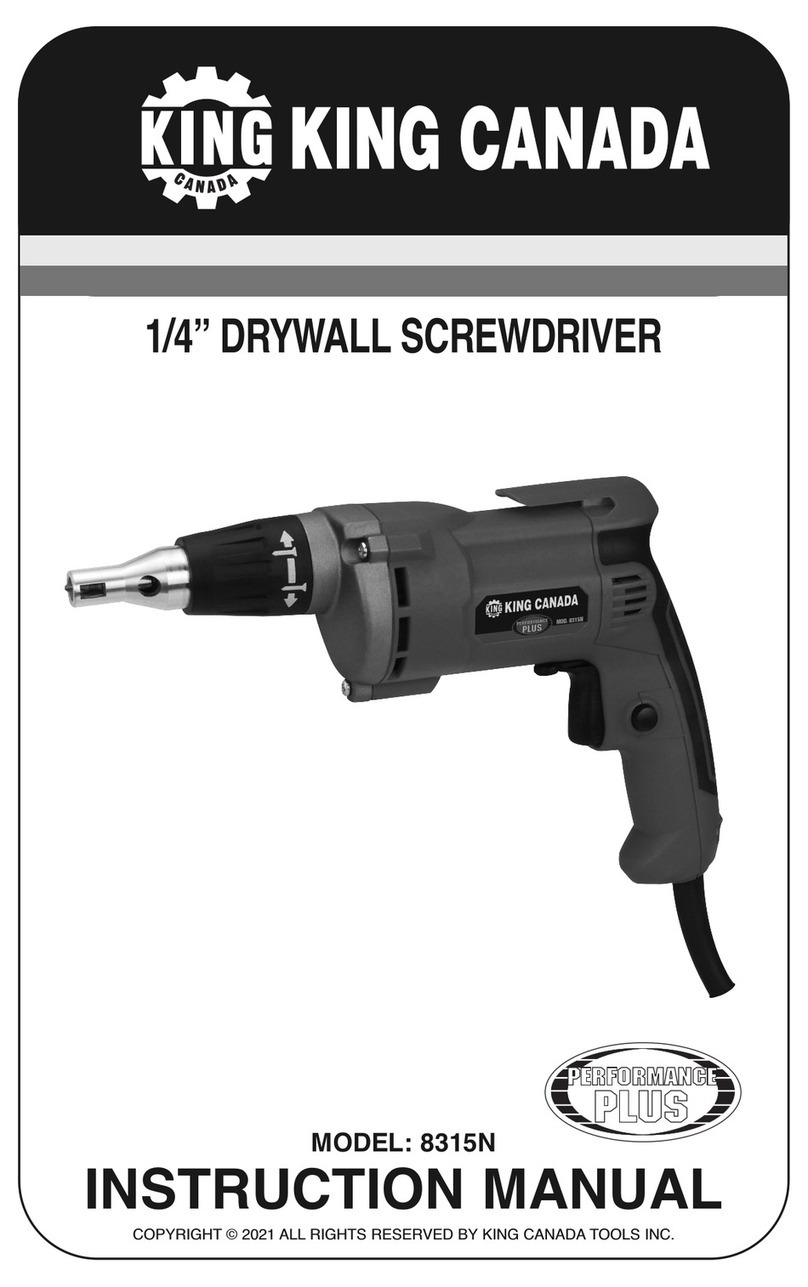
King Canada
King Canada PERFOMANCE PLUS 8315N instruction manual
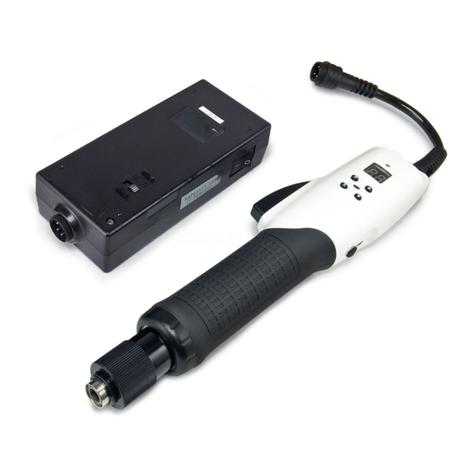
Kilews
Kilews SKD-BE512LF Operation and maintenance manual
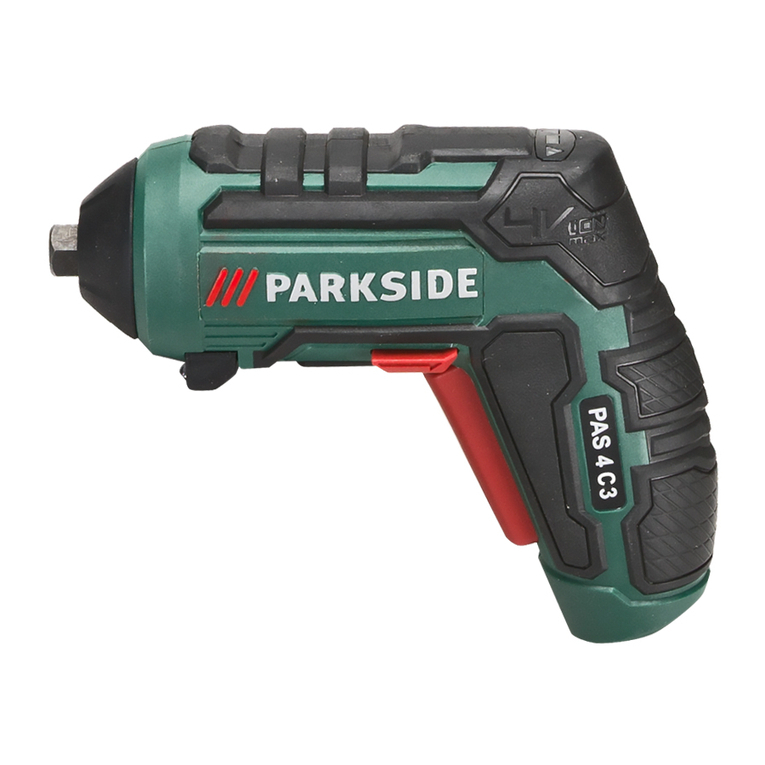
Parkside
Parkside PAS 4 C4 Original instructions
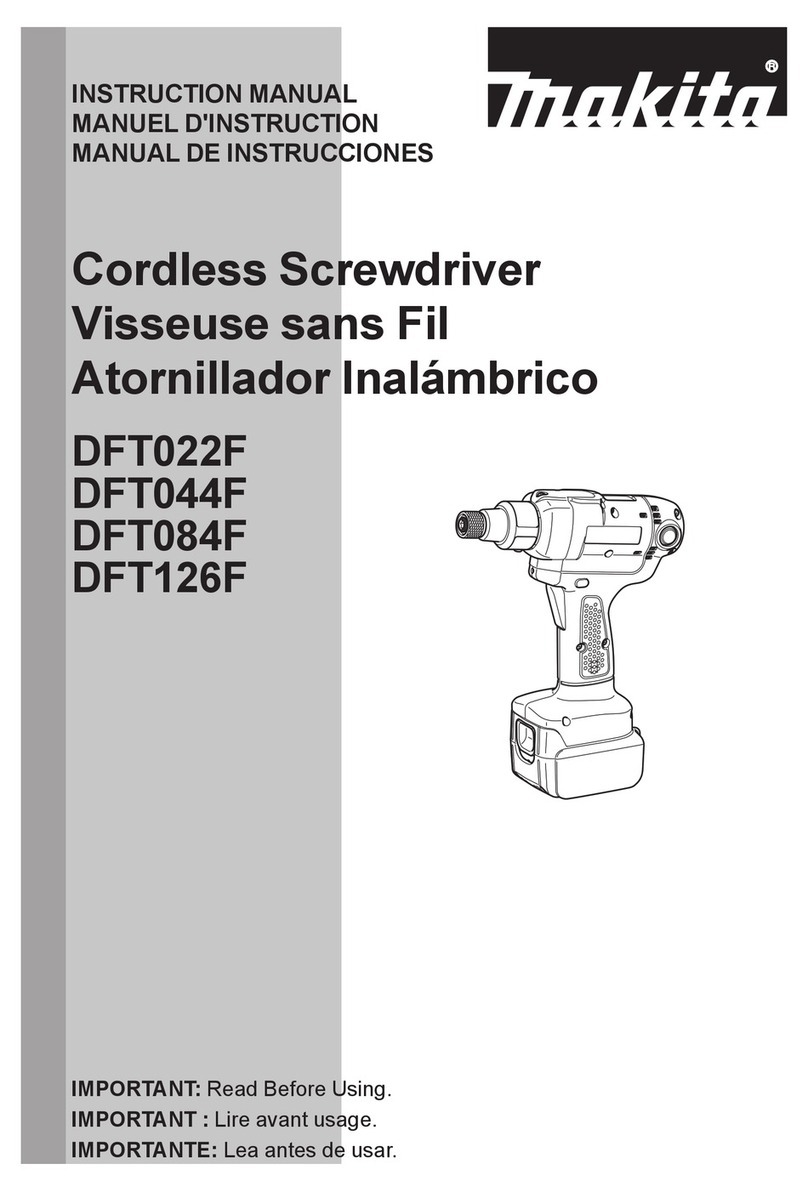
Makita
Makita DFT022F instruction manual

Black & Decker
Black & Decker BPCD120 manual
